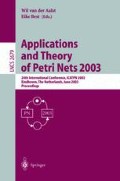Abstract
Fluidification is a common relaxation technique used to deal in a more friendly way with large discrete event dynamic systems. In Petri nets, fluidification leads to continuous Petri nets systems in which the firing amounts are not restricted to be integers. For these systems reachability can be interpreted in several ways. The concepts of reachability and lim-reachability were considered in [7]. They stand for those markings that can be reached with a finite and an infinite firing sequence respectively. This paper introduces a third concept, the δ-reachability. A marking is δ-reachable if the system can get arbitrarily close to it with a finite firing sequence. A full characterization, mainly based on the state equation, is provided for all three concepts for general nets. Under the condition that every transition is fireable at least once, it holds that the state equation does not have spurious solutions if δ-reachability is considered. Furthermore, the differences among the three concepts are in the border points of the spaces they define. For mutual lim-reachability and δ-reachability among markings, i.e., reversibility, a necessary and sufficient condition is provided in terms of liveness.
Supported by a grant from D. G. A. ref B106/2001
Partially supported by project CICYT and FEDER TIC2001-1819
Access this chapter
Tax calculation will be finalised at checkout
Purchases are for personal use only
Preview
Unable to display preview. Download preview PDF.
References
H. Alla and R. David. Continuous and hybrid Petri nets. Journal of Circuits, Systems, and Computers, 8(1):159–188, 1998.
G. Ciardo, D. Nicol, and K. S. Trivedi. Discrete-event simulation of fluid stochastic Petri nets. IEEE Trans. on Software Engineering, 25(2):207–217, 1999.
R. David and H. Alla. Continuous Petri nets. In Proc. of the 8th European Workshop on Application and Theory of Petri Nets, pages 275–294, Zaragoza, Spain, 1987.
F. DiCesare, G. Harhalakis, J. M. Proth, M. Silva, and F. B. Vernadat. Practice of Petri Nets in Manufacturing. Chapman & Hall, 1993.
J. Ezpeleta, J. M. Couvreur, and M. Silva. A new technique for finding a generating family of siphons, traps and ST-components. application to coloured Petri nets. In G. Rozenberg, editor, Advances in Petri Nets 1993, volume 674 of Lecture Notes in Computer Science, pages 126–147. Springer, 1993.
T. Murata. Petri nets: Properties, analysis and applications. Proceedings of the IEEE, 77(4):541–580, 1989.
L. Recalde, E. Teruel, and M. Silva. Autonomous continuous P/T systems. In J. Kleijn S. Donatelli, editor, Application and Theory of Petri Nets 1999, volume 1639 of Lecture Notes in Computer Science, pages 107–126. Springer, 1999.
M. Silva and J. M. Colom. On the computation of structural synchronic invariants in P/T nets. In G. Rozenberg, editor, Advances in Petri Nets 1988, volume 340 of Lecture Notes in Computer Science, pages 387–417. Springer, 1988.
M. Silva and L. Recalde. Petri nets and integrality relaxations: A view of continuous petri net models. IEEE Trans. on Systems, Man, and Cybernetics, 32(4):314–327, 2002.
M. Silva, E. Teruel, and J. M. Colom. Linear algebraic and linear programming techniques for the analysis of net systems. In G. Rozenberg and W. Reisig, editors, Lectures in Petri Nets. I: Basic Models, volume 1491 of Lecture Notes in Computer Science, pages 309–373. Springer, 1998.
K. Trivedi and V. G. Kulkarni. FSPNs: Fluid stochastic Petri nets. In M. Ajmone Marsan, editor, Application and Theory of Petri Nets 1993, volume 691 of Lecture Notes in Computer Science, pages 24–31. Springer, 1993.
Author information
Authors and Affiliations
Editor information
Editors and Affiliations
Rights and permissions
Copyright information
© 2003 Springer-Verlag Berlin Heidelberg
About this paper
Cite this paper
Júlvez, J., Recalde, L., Silva, M. (2003). On Reachability in Autonomous Continuous Petri Net Systems. In: van der Aalst, W.M.P., Best, E. (eds) Applications and Theory of Petri Nets 2003. ICATPN 2003. Lecture Notes in Computer Science, vol 2679. Springer, Berlin, Heidelberg. https://doi.org/10.1007/3-540-44919-1_16
Download citation
DOI: https://doi.org/10.1007/3-540-44919-1_16
Published:
Publisher Name: Springer, Berlin, Heidelberg
Print ISBN: 978-3-540-40334-0
Online ISBN: 978-3-540-44919-5
eBook Packages: Springer Book Archive

